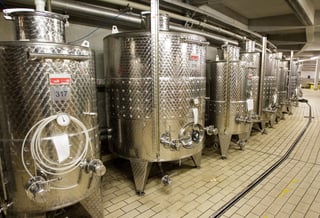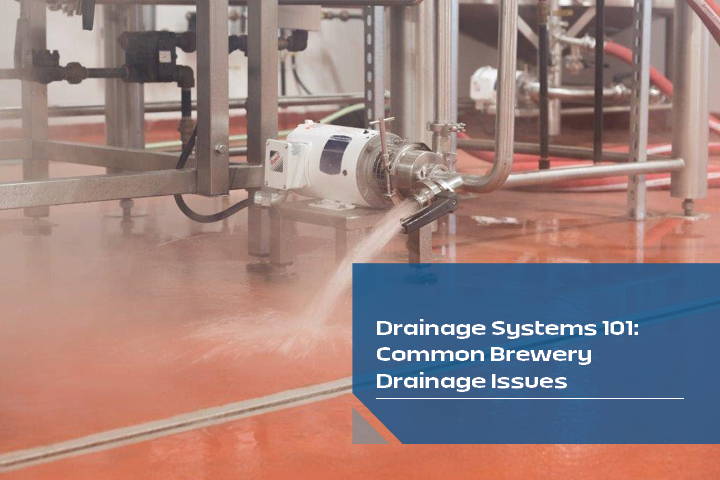As one of the oldest and broadly imbibed drinks, brewing is not simply a way to pay the bills, but is a way of life generally referred to as an art. In cities such as Denver, CO, breweries line streets and compete by offering unique assortments of tastes and individualized atmospheres.
Yet, with the growth of the brewing industry comes the reality of the craft and the responsibility for keeping patrons safe and the beer flowing.
One of the main issues that breweries struggle with is proper, efficient, and durable drainage systems.

Brewing uses a variety of substances including water, fermented starches (or grains), the seed cones and strobiles used for added hops, yeast, and, oftentimes, a clarifying agent such as seaweed, gelatin, or isinglass (a fish derivative). With such a diverse array of biological agents, brewery drainage is one of the most important aspects for a clean product and safe environment.
While drainage systems may be one of the most important and temperamental aspects of a brewery, there are a few common issues that can be easily avoided.
Choosing Your Drainage System
The key to long-lasting, issue-free drainage is the type of system you choose.
Many entrepreneurs new to the brewery business oftentimes opt for concrete drainage systems ornon-load rated grated trench due to the attractive price points. Yet, the nature of these materials is unreliable. Both options will easily corrode due to the chemicals and hydrogen sulfide gasses. Most systems offer a 10-year lifespan before erosion becomes a legitimate issue. The only solution is installing a completely new system. The cost of replacing a drainage system on a 10-year basis far outweighs the amount saved upon the first installation.
Indulge in reliability.
One of the highest rated materials for brewery drainage systems is stainless steel. Keep in mind that a drainage system is a permanent part the buildings infrastructure. Stainless may cost a bit more upfront but it is the standard in the food and beverage industry and provides savings over time.
Drainage System 101: Common Brewery Drainage Issues
1) Maintenance
The first and most obvious way to avoid issues with drainage is proper maintenance. While this may seem simple - basically, keep it clean - for breweries there are very specific ways to properly maintain your drainage system.
- Maintaining a Healthy Brewery Ecosystem
Maintenance is a full-time job. Keeping a clean drainage system doesn't simply focus on the drainage system itself, but on the entire brewery. The key is implementing regular cleaning schedules, using appropriate cleaning materials, and making sure to focus on the entire brewery as a whole and understanding how everything reacts and affects with one another.
All of these cleansing substances - from nitric acid to oxidizing agents, and even the scalding water laden with a mixture of bacteria and chemicals - flows directly into the drainage system, along with a host of other organic and inorganic materials. This co-mingling of substances must be addressed within your maintenance routine to make sure the drainage system is keeping up with the work.
These are all parts of a brewery ecosystem; natural bacteria and harmful bacteria, benign and malignant chemicals, and ranging temperatures. Understanding the interaction of these elements, especially when it comes to expelling them via your drainage system, is an important part of owning and operating a brewery.
- Cleaning the Drains
Per the Beall Brewery Insurance Agency, "consistency and scheduling [are] the two most important factors in brewery maintenance." This is incredibly important, especially when it comes to cleaning out brewery drainage systems, yet it's important to know what you're doing.
Cleaning Chemicals: Depending on your cleaning system, cleansers will be either caustic or acidic. Caustic cleansers use a higher pH, while acidic cleansers generally have a lower pH value. What you use will depend on the type of drainage system and it's condition.
Protective Gear: Be smart and where appropriate protective gear. Drainage systems are a place where toxic chemicals are expelled and dangerous bacteria may live. Protect your eyes with glasses, your hands with chemical-rated rubber gloves, and your body with either a dense rubber apron or full body suit.
Clean Water Act of 1972: Knowing the ins and outs of proper drainage cleaning is important, but it's also a brewery owner's job to know the legal requirements of disposing of toxic materials.
Per Jason Youngblood, amateur craft brewer, "The Clean Water Act, enacted in 1972, established pollution control programs such as setting wastewater standards for [the] industry. These standards include requirements and standardized measurements for BOD levels and Total Suspended Solids (TSS), among others. This law applies to breweries that dispose of their yeast in public water systems or bodies of water to which the Clean Water Act applies. Some breweries dump their yeast slurry into the drain. While this is a common practice, brewers should beware, unless that brewery’s drains lead to a large septic."
2) Surface Damage
One of the most common damage factors is directly related to the weight of machinery, such as pallet jacks / forklifts, that traverse over drainage grates. As the entry point to the drainage system, grates play a vital role in avoiding clogs, backing up, and flooding. Over-capacity machinery may warp or bend grates dislodging them from their configurations. This not only becomes a safety hazard, it can also damage equipment, and eventually will need to be replaced.
Therefore, if a brewery requires the use of heavy machinery, make sure to install a drainage system that is load rated to withstand heavy traffic - recommend load class E (forklift).
It's also important to consider the wear and tear that a brewery floor sustains over time. This includes high volume traffic of heavy machinery, accidents that involve heavy objects such as kegs and hoses that can cause cracks or dents, as well as foot traffic. The health, longevity, and efficiency of drainage systems relies upon its infrastructure.
Make sure to invest in quality flooring that is properly sealed and maintained. Concrete floors are the best option, yet even the best material requires upkeep. Avoiding corrosion through attentive building maintenance will result in financial savings.
3) Temperature
Brewing involves the careful regulation of temperature for successful fermentation. During cleaning, this means large fluctuations in temperature of liquids going down the drain, sometimes ranging from 140 to 200 degrees Fahrenheit.
As a part of the infrastructure, drainage systems tend to expand and contract due to the fluctuation of temperatures. Over time, this will cause improperly fitted components, as well as a separation of the drainage system from its housing. This separation opens the door for natural agents (such as the yeast and hops) to spur bacterial growth and ultimately cause health hazards for staff and consumers alike.
For drainage systems using concrete components, this type of infection will cause degradation. As most drainage systems use concrete as a housing agent, it’s important to understand how to avoid damage caused by temperature fluctuations.
Stainless steel is the recomended material for a proper drain system in a brewery. Stainless will not degrade with the high temperatures and is the most hygenic for the sanitary conditions of a brewery.
For more information and detailed specifications, download Slot Drain System's product guide:
Slot Drain Systems, founded in 1986, provides quality drainage systems and installation supported via a team of highly educated and thoroughly trained staff. Focusing on expansive installations, as well as troubleshooting wear and tear due to high volume use, Slot Drain Systems prides itself on tackling diverse projects. From heavy-duty drainage systems to animal facilities, landscaping, and commercial buildings, Slot Drain Systems has the resources to deliver great results. For more information or to speak with a representative directly, feel free to contact us.



